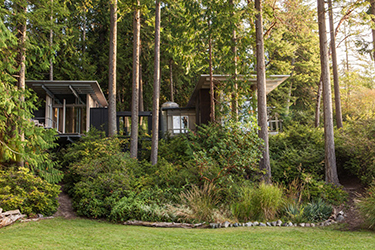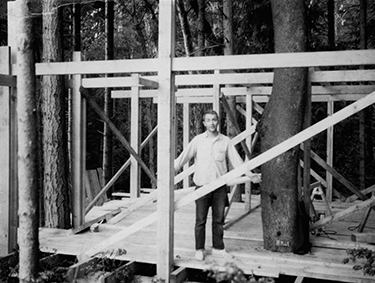|
Subscribe / Renew |
|
|
Contact Us |
|
| ► Subscribe to our Free Weekly Newsletter | |
| home | Welcome, sign in or click here to subscribe. | login |
Architecture & Engineering
| |
March 11, 2015
Jim Olson looks back on what he has learned over 56 years from a cabin
Journal Staff Reporter
Jim Olson has worked on his cabin in Longbranch on and off for 56 years.
It started in 1959 when he was 18 and his dad gave him $500 to design and build a bunkhouse for teenagers near the family's main house in Longbranch, overlooking Puget Sound and Mount Rainier.
Over the years — at ages 41, 61 and 74 — Olson designed and oversaw major additions to what is now a one-story, 2,400-square-foot cabin with daylight basement that he owns with his wife, Katherine.
Olson, now 74, is the founding partner of Olson Kundig Architects, a Seattle firm known internationally for designing high-end homes.
He is an American Institute of Architects fellow, in Interior Design Magazine's Hall of Fame and on Architectural Digest's top 100 list of designers worldwide.
Olson has explored the interplay of art, nature and design for nearly 50 years. Best known for residential design, he has also done commercial and mixed-use buildings, museums, religious spaces and hotels, including the Pike & Virginia building and Bellevue Botanical Garden Visitors Center.
The University of Washington alumnus is the subject of an installation called “Home Base” that looks at how his work on the cabin has affected work he does for clients. The exhibit was created by Olson's firm along with Ken Tadashi Oshima, a UW professor of architecture.
It runs through May 1 in the UW College of Built Environments' new Gould Pavilion. There are photos, sketches, models and materials, as well as a full-scale mock-up of part of the cabin.
Olson uses the cabin to test ideas, such as how to frame views of a tree, vista or hillside to connect people with nature.
“I do that a lot in my other projects,” he said, “but I think I learned that originally in the cabin.” Olson designed two apartments, two houses and the cabin for himself and his wife, who he said trusts him to create something good.
“I have a sense of freedom that is different than a typical project with a client,” he said. “The projects that I do for myself are more the real me. It all just comes out of me.”
While he loves working with clients, Olson said “there's something special about being able to design things for yourself, just the way you want to do it.”
The 200-square-foot Longbranch bunkhouse was built on posts and peeked through trees so it was almost invisible, Olson said, “as though it just grew there.”
The floor level of the current cabin, which is on a sloped site, is about 12 feet above grade at its highest point, and the structure is surrounded by a cloud of Huckleberry bushes.
“It is bigger and it isn't invisible anymore,” Olson said, “but it does completely weave in and out of the trees ... The forest actually is part of the design.”
Olson's designs for the cabin are grounded in practicality: The family needed more space, so the cabin grew.
The bunkhouse worked for more than 20 years, but didn't quite fit his growing family. So a tiny bedroom and tiny bathroom, what Olson calls “a great luxury outhouse with running water,” were added in separate buildings on either side of the bunkhouse.
As he and his wife got to be in their 60s, however, going outside and upstairs in the middle of the night to use the bathroom didn't quite work anymore.
So additions were made in 2004: a new bathroom that connects to the master bedroom, a treehouse-like living room and a deck.
“It was,” Olson said, “more about getting older.”
Like other homeowners, Olson found his needs and tastes have changed.
“I was a little wrapped up in the style of not having overhangs, and of course the roof leaked a little bit so it influenced (me) to go back to have overhangs in the Northwest,” he said.
Olson also designed the cabin with lots of windows, “but at night you felt a little exposed.” So in the 2014 addition the master bedroom was enclosed enough to provide refuge from the woods and “protection from darkness.”
He said he worries about cost and making the right design decisions on his homes, but has gone over budget many times because “you can't just have everything you want for a certain price.”
Working on his own homes affects how he works with clients. Designing a home is exciting and interesting, but can create anxiety. “I just try to put myself their shoes — because I've been in their shoes,” he said.
Part of the anxiety is because architecture expresses “how we like to live our life,” Olson said. So what does Olson's cabin — up a hill and behind trees — say about him?
“I like to stay in the background,” he said. “It's not a look-at-me house, but when you do see it there's a lot to see. It's just under the surface.”
It also shows he likes things just the way he wants them — “and beautiful.”
Grandchildren and friends visit, but Olson said mostly just he and his wife go to the cabin. “I get a lot of my most creative thinking done there.”
When he was younger, Olson was inspired by some mid- to late-20th century Northwest architects. He worked for Ralph D. Anderson and briefly for Paul Hayden Kirk, and is fond of work by Roland Terry and Arthur Erickson of Canada.
“They all did these simple buildings that are a complement to the organic topography and nature around them,” he said. “That influenced the cabin.” In the late 1950s, Kirk designed a house for Olson's aunt and uncle. “I fell in love with his work and I still am,” Olson said.
Olson said he likes being at the Longbranch cabin more than anywhere else.
“(It's) a huge luxury to be able to live close to nature,” he said. “I think it has a value that goes beyond anything anyone could buy.”
So what would the 74-year-old tell that 18-year-old designing the bunkhouse?
“I would just say know what is in your heart is the right thing to do. Follow your personal philosophy of what it should be like.”
Lynn Porter can be
reached by email or by phone
at (206) 622-8272.




